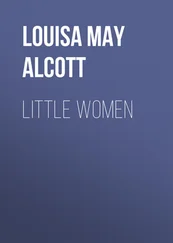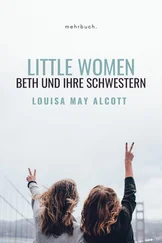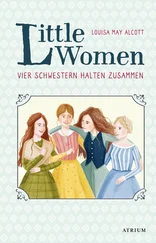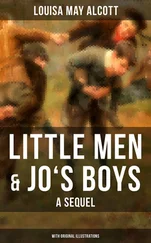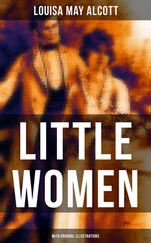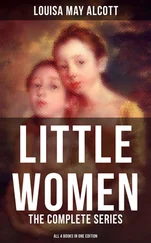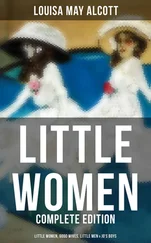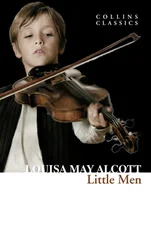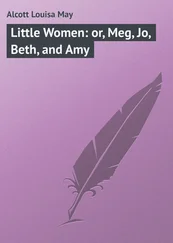Alcott’s cynicism about women’s traditional roles—and the impossible standards to which many women hold themselves in trying to adjust to a new prescribed role—does come across more directly on certain occasions in Little Women. The satirical “salute” to Babydom, which Meg and her husband, John, inhabit in chapter 38 following the birth of their twins, portrays one perspective on overindulgent parenthood but also reveals some limits on just how far the author was willing to stretch her patience in depicting the trinity of hearth, home, and husband as the pinnacle of success for any woman. “If [John] hinted at [attending] a lecture or concert,” Alcott writes, “he was answered with a reproachful look [from Meg], and a decided—‘Leave my children for pleasure, never!’” (p. 377). Alcott’s commentary on spinsters (her own social category) is also telling; she carefully entreats her readers not to laugh at older unmarried women, because “often very tender, tragic romances are hidden away in the hearts that beat so quietly under the sober gowns, and many silent sacrifices of youth, health, ambition, love itself, make the faded faces beautiful in God’s sight” (pp. 424-425). Alcott undercuts the seriousness of these ideas by joking that her readers, as Jo has done in the part of the story these passages interrupt, have probably fallen asleep during her digression, yet her points are well taken. This defense of spinsterhood, if sentimental, also comes across as perfectly sincere, and for very good reason.
Alcott’s Gothic sensational stories—of a type popular with the masses (and with Jo, until she is instructed otherwise) but considered rather lurid by the literary establishment of her day—offered her a bit more freedom than Little Women’s realism did. In some of these, Alcott pushes harder on girls’ impulses toward independence, evidenced by the innate (but usually suppressed) disrespect for authority that Jo demonstrates in Little Women. For example, the frustrated, impetuous teenage heroine of Alcott’s sensational novel A Long Fatal Love Chase (written in 1866 but not published until 1995)—the evocatively named orphan Rosamond Vivian—shrieks in a fit of adolescent pique to her uncaring grandfather that she would sell her soul to Satan for a year of freedom, rather than have to endure her stultifying, lonely life with him (a vow she comes to rue shortly after her grandfather’s mysterious friend Phillip Tempest wins her in a card game). Words such as those never issue from the mouth of Jo March, who, although somewhat constrained, at least has a loving home life. When Jo approaches such sentiments, she gets a moralizing lecture from Marmee or another March sister by way of counterpoint.
Some critics also regret, early in the book, the girls’ having to assume masculine identities in order to compose their family newspaper, based on Charles Dickens’s Pickwick Papers. Alcott personally knew the influential feminist writer Margaret Fuller, who edited the main transcendentalist journal, the Dial, and she easily could have adapted Fuller’s experience for her March sisters and had them create the newspaper without resorting to male drag. But had Alcott written the scene without the girls’ imaginative adoptions of famous fictional personae, would the newspaper meetings have been as colorful? Probably not, nor nearly as entertaining for children. Essentially, although Alcott’s choices in Little Women may be frustrating, we have to remember that the author’s goals for the novel—to sell books and to entertain children, both of which she achieved—are different from the ones we assign to her with hindsight.
It’s true that Alcott’s most famous novel is a period piece; but when compared to traditional nineteenth-century literature for children available at the time, Little Women’s protagonists are remarkably complex, even slightly—if an emphatic slightly—subversive. Generally speaking, the young characters in popular American children’s literature prior to Alcott’s time were either wholly wicked brats who entirely deserved the strict punishment they received or purely angelic little saints in whose mouths the proverbial butter could never melt. In either case, these fictional children spoke like little adults; one early criticism of Alcott’s novel involved the characters’ (especially Jo’s and Laurie’s) use of slang terms (Jo often uses work in the revised text, when she had used grub in the original) and quasi-cusswords, like “Jupiter Ammon!” and “Christopher Columbus!”—bone-chilling language, to be sure. (Contemporary critics also bemoaned the March girls’ shocking practice of staging plays on the Christmas holiday.)
In 1880 Alcott’s British publisher suggested a revised version of Little Women, one that would not only eliminate quirks of New England regional language (the word quinydingles, for example, was changed to notions) but also reduce much of the slang terminology in general to provide for a more ladylike tone. (This 1880 version is the one most readers today are familiar with, and it is used in the present Barnes & Noble classics edition.) Notwithstanding such changes, critic Barrett Wendell in his 1900 Literary History of America still insists of Little Women, “instead of unquestioning self-respect, its personages display that rude self-assertion which has generally tainted the lower middle class of English-speaking countries.” It is a testament to Alcott’s skill as a storyteller that the text still retains a youthful spirit of play and naturalness that the revision could not obscure.
As such, this Alcott novel is no great fantasy, for even if the characters may seem outrageously obedient and good in a young twenty-first-century reader’s mind, they exist in the realm of nineteenth-century possibilities. The March girls struggle with real problems—vanity, restraint, shyness, envy. In large part, the terms of their struggles make the difference. If pickled limes are no longer the forbidden vogue in school, as they are at Amy’s, perhaps illegally downloaded MP3 files are. Although the restrictions on Jo’s behavior and future doubtless are stronger than those today’s teens face, Jo’s choices demonstrate how she can begin to learn to live satisfactorily within those restrictions: She does marry, but we hope she only postpones her plans to travel the globe and her ambition to be a world-famous writer. Not every reader will view her compromise as positive, but young girls can still respond to Jo’s dilemma with understanding and empathy. And today’s young readers look to Little Women in particular, of course, to learn about what daily life might have been like for them had they lived in nineteenth-century America. Alcott’s detailed lessons, in this regard, work.
More than many other children’s novels, Little Women tends to compel commentators, female ones in particular, to discuss their own personal childhood impressions of the novel and how it affected their lives. This kind of retrospection in some ways can be frightening for what it reveals. Like many young girls, I was devoted to the book; I borrowed it from the library a few times a year and reread it obsessively in its entirety. (My mother eventually bought me a handsome illustrated hardcover edition, but it seemed somehow too pretty to mar through frequent use.) After my own childhood neuroses first helped me to identify in no small degree with Beth’s painful, extreme shyness, Jo ultimately won my allegiance as my favorite character. She was the kind of girl I wanted to be: outspoken, possessed of big dreams, a bit of a tomboy. I fancifully saw television’s nervous groundbreaker Mary Richards, from The Mary Tyler Moore Show— this character being a weekly combination of the petrified and the confident—as an adult Jo March for the 1970s (note, of course, Mary’s perpetually single romantic status). I too was disappointed in Jo’s choice of husband; I found Amy particularly annoying and liked Laurie very much. Later, I too was disappointed that Jo overcame her objections to marriage itself. I remember repeatedly feeling toward the book’s end as though the plot had run away from me; I’d gone along with everything up until the last few chapters. The book seemed to me to lose its charming day-by-day sense of detail once the marriage plots start weaving. The action speeds up dramatically, and the novel ends quickly following Jo’s marriage. I think my frustration at the result ruined all marriage-plot novels for me forever—after the marriage, I observed, comes the end of the story. Whatever happens after, I thought, isn’t even interesting enough to write down.
Читать дальше
Конец ознакомительного отрывка
Купить книгу

